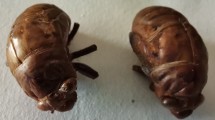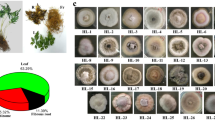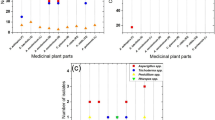Abstract
Limited knowledge currently exists regarding species diversity and antimicrobial activity of endophytic isolates of Preussia within Australia. This report describes endophytic Preussia species that were identified through molecular analysis of the internal transcribed spacer region. Screening for antimicrobial secondary metabolites was determined by testing crude ethyl acetate (EtOAc) extracts derived from fungal mycelia against a panel of ATCC type strains which included Bacillus cereus, Escherichia coli, Enterococcus faecalis, Pseudomonas aeruginosa, Serratia marcescens, methicillin-resistant Staphylococcus aureus (MRSA) and the opportunist yeast pathogen Candida albicans. Subsequently, high-performance liquid chromatography generated fractions of bioactive EtOAc extracts which were subject to confirmatory testing using the Clinical and Laboratory Standards Institute reference microdilution antimicrobial activity assay. A total of 18 Preussia were isolated from nine host plants with 6/18 having a <97 % sequence similarity to other known species in Genbank, suggesting that they are new species. In preliminary screening, 13/18 Preussia isolates revealed antimicrobial activity against at least one of the microbes tested, whilst 6/18 isolates, including 4/6 putative new species showed specific antimicrobial activity against MRSA and C. albicans. These results highlight the antimicrobial potential of Australian Preussia spp. and also the importance of Australian dry rainforests as an untapped repository of potentially significant bioactive compounds.



Similar content being viewed by others
References
Amin RM, Strobel GA, Vishnevetsky M, Ren Y, Geary B (2010) Biologically active endophytic Quambalaria sp. from Leptospermum junipae in Australia. Mycology 1(1):67–74
Aradi I, Erdi P (2006) Computational neuropharmacology: dynamical approaches in drug discovery. Trends Pharmacol Sci 27(5):240–243
Archibald L, Phillips L, Monnet D, McGowan JE Jr, Tenover F, Gaynes R (1997) Antimicrobial resistance in isolates from inpatients and outpatients in the United States: increasing importance of the intensive care unit. Clin Infect Dis 24(2):211–215
Arenal F, Platas G, Peláez F (2005) Preussia africana and Preussia isabellae, two new Preussia species based on morphological and molecular evidence. Fungal Divers 20:1–15
Arenal F, Platas G, Peláez F (2007) A new endophytic species of Preussia (Sporormiaceae) inferred from morphological observations and molecular phylogenetic analysis. Fungal Divers 25:1–17
Arnold A, Maynard Z, Gilbert G, Coley P, Kursar T (2002) Are tropical fungal endophytes hyperdiverse? Ecol Lett 3(4):267–274
Arnold A, Henk D, Eells R, Lutzoni F, Vilgalys R (2007) Diversity and phylogenetic affinities of foliar fungal endophytes in loblolly pine inferred by culturing and environmental PCR. Mycologia 99(2):185–193
Bell A (2005) An illustrated guide to the coprophilous Ascomycetes of Australia. Centraalbureau voor Schimmelcultures, Netherlands
Berdy J (2005) Bioactive microbial metabolites. J Antibiot 58(1):1–26
Bills G, Dombrowski A, Pelaez F, Polishook J, An Z, Watling R, Frankland J, Ainsworth A, Isaac S, Robinson C (2002) Recent and future discoveries of pharmacologically active metabolites from tropical fungi. In: Watling R, Frankland JC, Ainsworth AM, Isaac S, Robinson CH (eds) Tropical mycology: micromycetes, vol 2. CABI Publishing, Wallingford, pp 165–194
Boddington M (2009) Discovery and evaluation of novel antimicrobial agents against nosocomial pathogens. Master of science dissertation, University of Southern Queensland, Toowoomba
Camp D, Davis R, Campitelli M, Ebdon J, Quinn R (2012) Drug-like properties: guiding principles for the design of natural product libraries. J Nat Prod 75(1):72–81
Chang JH, Wang YZ (2009) The genera Sporormia and Preussia (Sporormiaceae, Pleosporales) in Taiwan. Nova Hedwigia 1(2):245–254
Chen X, Shi Q, Lin G, Guo S, Yang J (2009) Spirobisnaphthalene analogues from the endophytic fungus Preussia sp. J Nat Prod 72(9):1712–1715
Chen YP, Chen F (2008) Identifying targets for drug discovery using bioinformatics. Expert Opin Ther Targets 12(4):383–389
Clinical Laboratory Standards Institute (CLSI) (2006) Methods for dilution antimicrobial susceptibility test for bacteria that grow aerobically. Approved standard M7–A7. In: Clinical and Laboratory Standards Institute, Wayne, Pennsylvania
Coates A, Hu Y (2006) New strategies for antibacterial drug design: targeting non-multiplying latent bacteria. Drugs RD 7(3):133–151
Debbab A, Aly A, Edrada-Ebel R, Müller W, Mosaddak M, Hakiki A, Ebel R, Proksch P (2009) Bioactive secondary metabolites from the endophytic fungus Chaetomium sp. isolated from Salvia officinalis growing in Morocco. Biotechnol Agron Soc Environ 13(2):229–234
Felsenstein J (1985) Confidence limits on phylogenies: an approach using the bootstrap. Evolution 39:783–791
Gardes M, Bruns T (1993) ITS primers with enhanced specificity for basidiomycetes—application to the identification of mycorrhizae and rusts. Mol Ecol 2(2):113–118
Harden GJ, McDonald WJF, Williams JB (2006) Rainforest trees and shrubs: a field guide to their identification in Victoria, New South Wales and subtropical Queensland using vegetative features. Gwen Harden Publishing, Nambucca Heads, NSW Australia
Kowalski DT (1968) Morphology and cytology of Preussia isomera. Bot Gaz 129:121–125
Kruys Å, Wedin M (2009) Phylogenetic relationships and an assessment of traditionally used taxonomic characters in the Sporormiaceae (Pleosporales, Dothideomycetes, Ascomycota), utilising multi-gene phylogenies. Syst Biodivers 7(4):465–478
Kumaran R, Muthumary J, Hur B (2008) Production of taxol from Phyllosticta spinarum, an endophytic fungus of Cupressus sp. Eng Life Sci 8:438–446
Laniado-LaborÃ-n R, Cabrales-Vargas MN (2009) Amphotericin B: side effects and toxicity. Rev Iberoam Micol 26(4):223–227
Larsen TO, Smedsgaard J, Nielsen KF, Hansen ME, Frisvad JC (2005) Phenotypic taxonomy and metabolite profiling in microbial drug discovery. Nat Prod Rep 22(6):672–695
Lebel T, Tonkin JE (2007) Australian species of Macowanites are sequestrate species of Russula (Russulaceae, Basidiomycota). Aust Syst Bot 20:355–381
Levy SB, Marshall B (2004) Antibacterial resistance worldwide: causes, challenges and responses. Nature Med 10:122–129
Lv Y, Zhang F, Chen J, Cui J, **ng Y, Li X, Guo S (2010) Diversity and antimicrobial activity of endophytic fungi associated with the alpine plant Saussurea involucrata. Biol Pharm Bull 33(8):1300–1306
Peterson R, Bradner J, Roberts T, Nevalainen K (2009) Fungi from koala (Phascolarctos cinereus) faeces exhibit a broad range of enzyme activities against recalcitrant substrates. Lett Appl Microbiol 48(2):218–225
Phongpaichit S, Rukachaisirikul V (2006) Antimicrobial activity in cultures of endophytic fungi isolated from Garcinia species. FEMS Immunol Med Microbiol 48(3):367–372
Raviraja N, Maria G, Sridhar K (2006) Antimicrobial evaluation of endophytic fungi inhabiting medicinal plants of the Western Ghats of India. Eng Life Sci 6(5):515–520
Redman RS, Freeman S, Clifton DR, Morrel J, Brown G, Rodriguez RJ (1999) Biochemical analysis of plant protection afforded by a nonpathogenic endophytic mutant of Colletotrichum magna. Plant Physiol 119(2):795–804
Rodriguez R, White J Jr, Arnold A, Redman R (2009) Fungal endophytes: diversity and functional roles. New Phytol 182(2):314–330
Saitou N, Nei M (1987) The neighbour-joining method: a new method for reconstructing phylogenetic trees. Mol Biol Evol 4:406–425
Sakoulas G, Moellering RC Jr (2008) Increasing antibiotic resistance among methicillin-resistant Staphylococcus aureus strains. Clin Infect Dis 46(Supplement 5):S360–S367
Strobel G (2003) Endophytes as sources of bioactive products. Microbes Infect 5(6):535–544
Tamura K, Dudley J, Nei M, Kumar S (2011) MEGA5: molecular evolutionary genetics analysis using maximum likelihood, evolutionary distance, and maximum parsimony methods. Mol Biol Evol. doi:10.1093/molbev/msr121
Taylor, Francis Group (2012) Dictionary of Natural Products on DVD. CRC Press, London
Thompson J, Higgins D, Gibson T (1994) Clustal W: improving the sensitivity of progressive multiple sequence alignment through sequencing weighting, position sequence gap penalties and weight matrix choice. Nucleic Acids Res 22:4673–4680
Vaz AB, Mota RC, Bomfim MR, Vieira ML, Zani CL, Rosa CA, Rosa LH (2009) Antimicrobial activity of endophytic fungi associated with Orchidaceae in Brazil. Can J Microbiol 55(12):1381–1391
Vilella D, Sánchez M, Platas G, Salazar O, Genilloud O, Royo I, Cascales C, Martin I, Diez T, Silverman K (2000) Inhibitors of farnesylation of Ras from a microbial natural products screening program. J Ind Microbiol Biotechnol 25(6):315–327
Weber HA, Gloer JB (1991) The preussomerins: novel antifungal metabolites from the coprophilous fungus Preussia isomera Cain. J Org Chem 56(14):4355–4360
White T, Bruns T, Lee S, Taylor J (1990) Amplification and direct sequencing of fungal ribosomal RNA genes for phylogenetics. In: Innis MA, Gelfand DH, Sninsky JJ, White TJ (eds) PCR protocols, a guide to methods and applications. Academic Press, San Diego, pp 315–322
Acknowledgments
Rachel Mapperson is supported by an Australian Postgraduate award.
Author information
Authors and Affiliations
Corresponding author
Electronic supplementary material
Below is the link to the electronic supplementary material.
Rights and permissions
About this article
Cite this article
Mapperson, R.R., Kotiw, M., Davis, R.A. et al. The Diversity and Antimicrobial Activity of Preussia sp. Endophytes Isolated from Australian Dry Rainforests. Curr Microbiol 68, 30–37 (2014). https://doi.org/10.1007/s00284-013-0415-5
Received:
Accepted:
Published:
Issue Date:
DOI: https://doi.org/10.1007/s00284-013-0415-5




